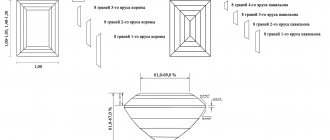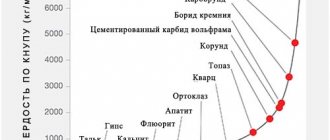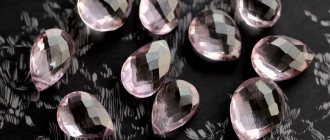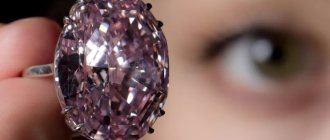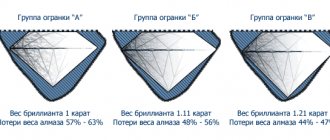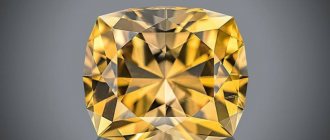Greetings friends! Do you know what is the difference between a diamond and a diamond? Or maybe they are one and the same? I will tell you all the most interesting things about how a diamond is transformed into a brilliant, what path it takes and by what criteria diamond cutting is assessed in the modern world, in Russia and in the West.
A diamond is a diamond, only after it has been cut. There are a lot of finishing variations. But I especially want to highlight the so-called rocks. This finishing is also used, but not so often.
A brilliant cut is not a nugget shape. The name comes from the word “face”, and therefore means the number of faces and location. In simple words, this is nothing more than polishing. The ability of the nugget to reflect light and please the eye will depend on its quality and character. Do you know who developed the classic diamond cut, which is still used today, how it is classified and does it affect the cost of the breed? The most interesting things are below!
What is a diamond cut?
Cutting is the process of giving a shape to a diamond, which can highlight its noble color and remove natural defects, giving a glow to the gemstone.
Diamonds are cut by hand. This process is painstaking and thorough, and the quality of the cut and the further fate of the stone directly depend not only on the quality of the diamond, but also on the skill of the cutting specialist. The type, shape and cutting method of each crystal is selected depending on its size, weight, color characteristics and purity. The main objective of the diamond cutting process is to maintain its carat weight, and then to balance the clarity (presence of defects) and color of the diamond.
Trilliant cut shape
A wedge cut with a triangular shape. There are several names for this shape: trillions, triangles or trillians. The shape and number of facets of these diamonds can vary significantly, but trillions have one thing in common - an invariably triangular shape.
Trilliates first appear in Amsterdam. This type of cut does not have any restrictions in terms of design - preference is given to the personal taste of the cutter and the natural parameters of the stone itself. The more traditional shape has sharp corners, but more rounded options are also possible.
Very often, trillions are found as side inserts in rings that have a larger stone. The width and length values should be as close as possible, only small deviations are allowed.
Trilliant diamond catalog
Trilliant diamond ring catalog
Diamond, step and mixed cuts
Brilliant cut is a method of diamond processing in which the arrangement and number of facets give the stone maximum brilliance. This is a perfectly calibrated diamond shape, revealing its ability to reflect and refract light. For example, the classic round cut of a gemstone is a brilliant cut. Such a stone must have 57 facets.
A step cut is characterized by a strictly parallel arrangement of edges, which means the shape of the stone will be square or rectangular (very rarely, trapezoidal). This cut of the diamond does not add much brilliance or play of light, but favorably emphasizes the purity, transparency and depth of color of the stone. The most common step cut forms are emerald and baguette.
The mixed cut combines the features of both brilliant and step cuts. It is used when it is necessary to maintain the maximum weight of a gemstone, while emphasizing its color and quality characteristics. The most attractive and popular shape of this cut is the princess.
All non-classical round cut diamonds are called fancy. These include pear, heart, oval, marquise, cushion.
Standard Diamond Processing
In the 21st century, all stages of the cutting process have been precisely developed. Science and technology make it possible to model future diamonds in 3D format by entering the necessary parameters into the program. This eliminates the need for the craftsman to determine the number, length and width of edges by eye.
There are 4 stages in the birth of a diamond. How diamonds are cut:
- The stone is scanned with X-rays, looking for cracks in it. X-rays are used to determine the exact position of the diamond in the mined rock. Based on the information received, a cut is made.
- After being separated from the rock and divided into pieces, each specimen is subjected to grinding on a specially designed lathe. This gives the stone the intended shape and the required number of edges.
- Next, the diamond is generously treated with diamond powder mixed with olive oil and polished on special iron wheels. This gives smoothness.
- Polishing completes the process. With its help, the product acquires its final shine.
In addition to watching a program about cutting in Russia:
Circle
The circle cut has 57 facets (the generally accepted designation is Kr 57). This is perhaps the most popular diamond shape today.
It is designed specifically to maximize the shine of the stone. However, small defects and color tints in round diamonds will be less noticeable compared to stones of other shapes.
Many buyers prefer round diamonds, deservedly considering them classics.
Nowadays you can find round-cut diamonds with 17 facets (indicated on the product tag as Kr 17). In this way, small diamonds with a diameter of 0.7 to 1.2 mm are cut, which are attached as accompanying large or medium-sized diamonds, or in the form of diamond “sprinkling”, when the surface of the jewelry is as if strewn with small stones, as well as in diamond “paths” . The 17-facet circle cut allows you to maintain a balance between the brilliance and price of the diamond.
A little history of cutting
People have been processing stones, in particular diamonds, for several centuries. Before they learned how to polish diamonds, making them shine in the sun, they had almost no value among jewelers. Uncut stones looked too ordinary to inspire creativity. The first attempt to refine the mineral was made in the 14th century. Then they tried to polish its natural edges. By the end of the century, diamonds gradually began to turn into polished diamonds, attracting more and more attention to them.
In the 15th century, diamond cutting reached a new level, despite the fact that almost half the mass of the nugget was lost in the process. The popularity of diamond grew, but it was still inferior to gems - ruby and sapphire.
At the end of the 15th century, the master polisher of Bruges got down to business. He came up with the idea of arranging the faces of the mineral in absolute symmetry. I used my own invention for this. To achieve the perfect result, Brugge shaped the azmaz into pear, triangle and briolette shapes.
After another half a century, a new fashionable cut appeared - rosette or rose. The first stones processed in this way adorned the jewelry of Belgian craftsmen. The rose finish has been and remains more than popular. Many of the largest diamonds in the world were treated with roses. Example - Sancy and Orlov (India).
Diamond cuts in the form we know today only appeared in the mid-17th century. The finished nuggets were distinguished by 17 precise edges on the upper part of the surface. This finishing method was called double cutting. Over time, they came to the conclusion that the stone plays with light more and brighter if you add facets. A jeweler from Italy, Vincent Perutzi, proposed almost doubling their number. Even this was enough for the diamond to shine many times more than before. The name of the finish is Mazarin. Compared to Rose, she is more edgy and modern, but still not as vibrant as the later ones.
Two cutting options - Rose and Mazarin - were successfully used throughout the 19th century. And only at the beginning of the 20th century the first jewelry machines and professional diamond equipment appeared. Round cut diamonds have become fashionable.
The famous mathematical genius Tolkovsky came up with a special model for diamond processing that takes into account the properties of the nugget. However, the then perfect model today seems outdated. Stones cut according to Tolkowsky's principle reflected light only 2 times, whereas today this number has increased several times. Although at that time the theory of mathematics gave impetus to the development of the art of diamond processing.
In 1970, another scientist proposed a variant of diamond cutting. Its fundamentals are still used today as the basis for the formation of a computer model in rock finishing.
Radiant
The radiant cut is always a rectangular or square shape with slightly truncated corners. This cut is also a brilliant cut; it combines the best qualities of the “princess” and “emerald” shapes.
“Radiant” refers to a mixed type of cut and has high brilliance levels of the diamond, and also favorably emphasizes the shade of the gemstone. Fancy diamonds are cut in this form, which allows their color to be conveyed as brightly as possible. Such stones are very rare to find, and due to their strict shape, they are more often chosen by men.
Diamonds with poor symmetry
| A round, oval-shaped diamond with a “butterfly” visual effect. This effect can often be found in fancy-cut diamonds in the shape of an oval and a drop (pear). | A 1 carat diamond with a diameter of 6.7 mm is stretched in diameter and has asymmetrical facets. An ideal cut diamond with this diameter should weigh 1.12 carats. |
| Height/Diameter,% | Area/Diameter,% | Diamond Cut Grading |
Move the sliders to visually see the impact of proportions on how a diamond interacts with light.
How diamonds are cut
When you see the final product, you hardly think about how it was produced and how much work it cost its creators. Same with a diamond. Until you understand the intricacies of the process, you will not begin to value your jewelry as much as you should.
We decided to initiate you into the holy of holies and tell you how and what those very edges do that turn an uncut stone into a magical and desired diamond.
- The crystal is split. It happens that X-rays reveal defects inside a mineral, and then they need to be removed.
- On a special machine, the diamond is peeled, giving it corners and edges.
- The actual grinding takes place on an iron polishing wheel. Diamond powder is first poured onto it; it helps to sharpen the stone to an almost perfect state. It turns out that the diamond “processes itself.”
- Polishing. The final stage of giving the diamond shine.
When the process has already been established and the master has adapted and gained a lot of experience, the production of high-quality, defect-free stones goes like clockwork. If there is not enough experience, mistakes are possible, due to which diamonds are rejected for not meeting quality standards.
For example, a dome that is too large will cause light to be reflected incorrectly. It will come out not through the top, but through the bottom of the product. A disproportionately high height also leads to marriage.
If too large facets are applied to a large specimen, it will not play and refract the rays, which is why it will look dull and not a diamond at all.
Well, when a small stone doesn’t have enough edges, it will look more like a milky gem, and not like a legendary and luxurious diamond. In a word, the slightest mistake and the stone, instead of the counter of a fashionable jewelry boutique, ends up in a box with the inscription “reject”, and the master himself, with a high probability, remains without a job.
Before cutting, it is important to take into account the natural shape of the stone, with all its defects. To minimize the loss of precious source material, it is better to first create a model of the finished product on the computer.
Well, we’ve looked at the processing methods, it’s time to admire the types of cuts. At the same time, apply today's knowledge in practice. If you have a “treasury” of diamonds at home, open it and look at it. No? No problem. This is a great reason to visit a jewelry store with your loved one and surprise him with your knowledge in the field of jewelry!
Marquise diamond, shuttle-shaped
In the diamond collection of Cardinal Mazarin, who lived in the early Baroque era, there was a diamond weighing more than 15 carats, similar in shape to the modern “Marquise” - then such diamonds were called “Navette”, i.e. a shuttle or a small boat, and cut from elongated diamonds. The name of the Marquise diamond probably appeared only a century later thanks to the famous smile of the Marquise de Pompadour, a passionate lover of art and luxury, the favorite of King Louis XV. According to legend, the king wished to give the marquise a diamond shaped like her radiant smile. Therefore, in the 21st century, we can safely say that the Marquise diamond has become a traditional classic, although it was first presented to the public several decades ago.
Fifty-five-sided Marquis diamond
An elegant oblong-cut Marquise diamond looks spectacular surrounded by small diamonds that smooth out its wedge-shaped ends. The elongated shape of the Marquise diamond creates the effect of long and narrow lady fingers.
Octagonal Emerald Diamond
The “Emerald” diamond is a purebred representative of the stepped cut type with truncated corners, having an octagonal outline. This type of cut has less “play”, but the brilliance of the diamond is revealed in wider and brighter flashes of light. If the shape of an Emerald diamond is square, it is called an Asscher diamond.
Rectangular diamond cut "Emerald" sixty-five-sided
Refined and elegant, the Emerald diamond is mainly used in rings. The emerald cut has its own peculiarity - it easily reveals the stone's flaws, so diamonds must be of high quality and purity. The square-shaped Asscher cut emerald is becoming increasingly popular these days.

